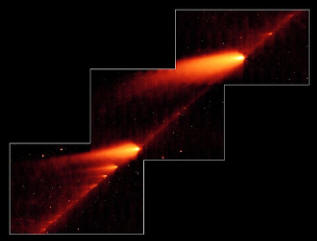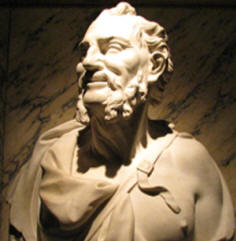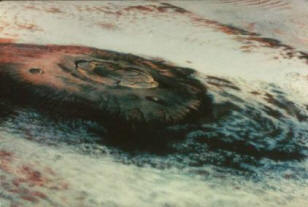|
|
|
 
Left: This infrared image from
NASA’s Spitzer Space Telescope shows
the broken Comet 73P/Schwassmann-Wachmann
3 skimming along a trail of debris
left during its multiple trips
around the sun. The flame-like
objects are the comet’s fragments
and their tails, while the dusty
comet trail is the line bridging the
fragments. © NASA/JPL-Caltech/W.
Reach (SSC/Caltech), 2006 May 10.
Right: Marble bust representing
Democritus of Abdera (±460-±370
BCE), who argued that comets are
composite bodies. Venice, 1700-1750
CE. Courtesy of the Victoria &
Albert Museum, London, United
Kingdom.
De-Tailing Comets
Dec 06, 2010
Science does not always
progress. A major setback in the
astronomy of the Graeco-Roman world
was the widespread adoption of the
Aristotelian worldview.
One of many fields affected by
the rise of Aristotle’s star was the
theory of comets. With much verve,
Aristotle advanced his specious
argument that comets do not exist in
space, in the arena dominated by
planets and stars, but are
restricted to the atmosphere – or
what the philosopher would call the
element of ‘air’.
Lacking any solid substance, comets
were simple ‘fires’ occupying the
same phenomenological slot as what
are known today as meteors, aurorae
and even the Milky Way, when the
comet stands on its own, or as
haloes, when it forms as a
‘reflection’ of the antics of a star
or a planet. In asserting this
palpably false opinion, Aristotle
marked a signal departure from a
bevy of pre-Socratic thinkers who
had lumped comets and planets
together.
Yet curiously, from a modern
perspective these early
theoreticians appear to have had a
better grasp on comets than
Aristotle, who actually understood
heads nor tails of the phenomenon.
According to Aristotle, 'some of the
so-called Pythagoreans say that a
comet is one of the planets, but
that it appears only at long
intervals and does not rise far
above the horizon'. Hippocrates of
Chios (±470-±410 BCE), whose ideas
displayed strong Pythagorean
streaks, and his disciple Aeschylus
'maintain that the tail does not
belong to the comet itself, but that
it acquires it …' The pair also
reasoned that the comet 'appears at
longer intervals than any of the
other stars because it is the
slowest of all in falling behind the
sun …'
Another contemporary, Diogenes of
Apollonia, classified comets as
‘stars’, a term that generally
included the planets. Apollonius of
Myndus (Fourth century BCE) is on
record with his belief that 'many
comets are planets … a celestial
body on its own, like the Sun and
the Moon'.
The conviction that comets are
physical bodies in their own right
facilitated the early theory,
vigorously brushed aside by
Aristotle, that they result from a
conjunction of planets. Democritus
of Abdera (±460-±370 BCE), for
example, opined that comets are a
'coalescence of two or more stars so
that their rays unite.' Thinking
along similar lines, Anaxagoras of
Clazomenae (±500-428 BCE), too, held
that 'two or more stars being in
conjunction by their united light
make a comet', 'when they appear to
touch each other because of their
nearness'.
Leucippus of Miletus (±480-±420 BCE)
was cited to a similar effect:
'Comets are due to the near approach
to each other of two planets'. Much
later still, the spiritual father of
Stoicism, Zeno of Citium (Third
century BCE), judged 'that stars
come together and combine their
rays, and from this union of light
there comes into existence the image
of a rather long star'.
To a modern cometologist,
proto-scientific speculations of
this sort seem far more up to speed
than Aristotle’s vapid postulate
that all comets are disturbances in
what we would call the earth’s
atmosphere. In grouping comets with
planets, the pre-Socratics listed
above anticipated the modern
understanding of comets as bodies in
the Solar System, whose paths may
intersect with those of planets.
Their suspicion that comets are
planets orbiting at extremely long
intervals is vindicated by current
knowledge of the periodicity of many
comets – including, of course, Comet
Halley’s well-known cycle.
More recent discoveries have tended
to corroborate even more of the
‘hunches’ Aristotle so vociferously
opposed. Observations of the rocky
cores of some comets, such as Tempel
1 in July 2005, suggest a common
ancestry not only with asteroids,
but with the rocky planets occupying
the inner region of the Solar System
themselves – a far cry from
Aristotle’s doctrine that only the
element of fire can exist in the
superlunary realm.
Conversely, detection of the plasma
tails of Venus, Mercury and the
earth, and the sodium tails of
Mercury and the moon has elicited
frequent comparisons to the tails of
comets in cutting-edge scientific
reports. Even solar prominences, now
documented in extensive detail,
might suggest a comet-like appendage
to the intellectually adventurous.
Aristotle’s opinion, which was to
dominate scholarly consensus in the
western world until the Seventeeth
century, was informed more by the
preconceived axiom that everything
in the planetary and starry heavens
is perfect and immutable than by
actual, unbiased observation. Bodies
moving on seemingly erratic paths
and exhibiting unpredictable
behaviour would upset the
mathematical elegance Aristotle and
his Platonic and Pythagorean
colleagues detected in their growing
models of planetary orbits.
Aristotle’s banishment of comets
from the serene stage of perpetually
unerring motion was really a
striking demonstration of a
so-called topdown theory – quite
unlike the bottom-up methodology
that has been cultivated since the
onset of the intellectual revolution
in Renaissance Europe. To be sure,
Aristotle did cite observational
evidence in his treatment of the
subject; however, his predilection
for ‘pure reason’ shows when he
changes tack to confront competing
views with the claim that 'the
theory can be shown to be wrong on
purely logical grounds'.
The careful reader of his
Meteorology also perceives a
certain laziness in the pundit’s
efforts to explore the pre-Socratic
theories of comets to their fullest
extent. Aristotle’s refutation of
the view that comets are akin to
planets may look superficially
plausible, but really rests on a
tacit but erroneous assumption that
comets, like planets, ought to move
on the ecliptic plane. In reality,
they are free to roam the precincts
of the planets under any angle they
see fit.
If Aristotle’s cardinal error was to
accord greater status to supposedly
undefiled reason than to the tested
method of construing theories by
deduction from sets of observation,
the reverse appears to be equally
true for his maligned predecessors.
The puzzling idea that comets are
the product of ‘planets’ in
conjunction derived at least in part
from direct observation; Democritus,
for one, 'has defended his view
vigorously, maintaining that stars
have been seen to appear at the
dissolution of some comets'.
In support of that, the Greek
historian, Ephorus of Cyme (Fourth
century BCE), claimed that a comet
once observed by all mankind ‘split
up into two stars, a fact which no
one except him reports’. The
reference was evidently to the
splitting of cometary nuclei, as
frequently recorded in modern times.
Meanwhile, Hippocrates’
perspicacious argument that the tail
is an accessory to the comet could
easily have suggested itself if
so-called ‘tail disconnection
events’ had been observed in
Antiquity.
Current knowledge of the
pre-Socratic contemplation of comets
amounts to little more than the few
surviving snippets cited above. The
loss of an entire body of literature
precludes the possibility to
determine exactly which observations
led to the remarkably precocious
hypotheses that preceded Aristotle.
The Pythagorean penchant for
information of Babylonian extraction
agrees with Apollonius’ intimation
that the scholars who analysed
comets as astral objects were ‘Chaldaeans’.
While Assyriologists have been able
to furnish only meagre support for
that statement, it is certainly
conceivable that Babylonian
astrologers passed on a body of
traditions, perhaps never committed
to writing, that would have firmly
pointed towards a deep affinity
between comets and planets.
A larger incidence of comets in the
early Holocene, for which some have
argued, would naturally have aroused
more interest in cometary diversity
and nature. As discussed elsewhere,
memories of a prehistoric time when
Venus’ plasma tail appeared within
the visible spectrum seem to have
persisted in a variety of cultures,
including late 3rd-millennium BCE
Mesopotamia.
It has also been argued that planets
in conjunction may have produced
fireworks if, at times of electrical
instability, their pointed tails
lined up, brushing against each
other. In Seneca’s words, it is then
that 'the space between the two
planets lights up and is set aflame
by both planets and produces a train
of fire'.
One of the last echoes of the
pre-Socratic idea that comets ensue
when planets approach each other may
have been Plato’s pithy reference to
the mythical Phaethon as a past
agent of catastrophe towards the end
of a ‘Great Year’. Did Plato think
of Phaethon as an earth-bound comet
spawned as all known planets
arranged in a linear conjunction?
Whatever the answer may be, Plato
and his precursors unquestionably
count as greater trailblazers in
cometology than Plato’s pupil
Aristotle, who threw caution into
the wind along with the comets.
Rens Van Der Sluijs
http://mythopedia.info
Books by Rens Van Der Sluijs:
The Mythology of the World Axis
The World Axis as an Atmospheric Phenomenon
Multimedia

“The
Thunderbolt that Raised Olympus
Mons”
|
|
|
|
|
|
|
|
|
YouTube video, first glimpses of Episode Two in the "Symbols of an Alien Sky"
series.
|
|
|
|
|
|
|
Three ebooks in the Universe Electric series are
now available. Consistently
praised for easily understandable text and exquisite graphics.
|
|
|
|
|
|
|
|
|
|









